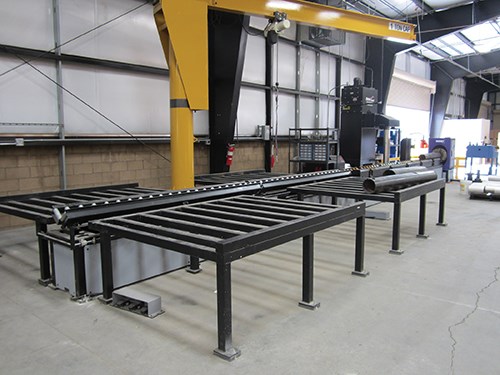Plasma Pipe-Cutting Machines Speed Filtration System Production
This water filtration manufacturer's slow plasma-cutting capabilities left behind too much slag. Two new CNC pipe-cutting machines helped to solve the problem.
Share



Yardney Water Filtration Systems is a manufacturer of water filtration equipment for the agricultural, food, municipal and HVAC industries. In the 1960s, the company developed equipment to enable farmers in the rich growing regions of Southern California to remove sand, silt, grit, algae and other contaminants from the water supply. To date, Yardney has developed more than 100,000 standard and custom engineered water filtration systems for its various customers.
Production of these systems starts by manufacturing three- to four-foot diameter pressure vessels from steel or stainless steel, with holes to connect pipes that will move water through the filtration unit. A number of pipes with holes must be cut before all of the pieces can be welded together and then painted.
Chris Phillips, vice president and general manager of the Riverside, California-based company, says Yardney realizes its manufacturing processes need to be as efficient as the water filtration systems it produces.
Recently, the company determined its existing plasma pipe cutting machine wasn’t providing the requisite throughput or cut quality. It had two major shortfalls. First, there wasn’t an easy way to load and unload pipes into and out of the machine, which caused a production bottleneck. Second, it left quite a bit of slag that had to be manually ground off the pipes prior to welding operations. In addition, the machine was experiencing increasingly frequent mechanical and electrical issues, resulting in high service costs and downtime.
Yardney considered various CNC plasma pipe-cutting options, ultimately choosing two Roto Hornet 1000 machines from Retro Systems with QuickPipe parametric pipe-cutting software, Hypertherm Maxpro200 air and oxygen plasma systems, and pneumatic pipe-handling systems.
The machines offered a number of advantages over the previous equipment. The Maxpro200 plasma cutting system, when combined with the Roto Hornet’s improved motion control, leaves behind virtually no slag. This minimizes the amount of manual grinding needed to prepare pipes for subsequent welding operations. Positioning speed is 1,200 ipm compared to 100 ipm with the previous equipment. Plus, an effective fume extraction system captures smoke at the point of the cut so it does not contaminate the shop—keeping the company in compliance with California Air Quality Management District regulations.
All of these features have made it possible for Yardney to create an extensive array of precision pipe profiles in an efficient amount of time. Some cuts, such as pipe notch cuts that would have taken four hours with the old system, are now completed in only five minutes.
Programming is simpler than the previous equipment’s DOS-based software, too. The QuickPipe parametric CAM software with graphical user interface (GUI) enables the user to configure various end types and intersection types to be cut, including straight, miter, cope, slotted and branch cuts. The previous equipment didn’t offer as many cut shapes, so some shapes had to be cut manually. To program a new job, the user selects a pipe diameter and wall thickness, defines the “end 1” and “end 2” cuts (for each pipe end), and defines any intersecting pipes per their location and orientation. NC code is automatically created from that information.
The company also found that Retro Systems’ pneumatic pipe-handling system enabled operators to quickly and safely load and unload pipe to maximize production. Staging racks handle full-length pipe and cut parts. Instead of loading only one pipe at a time, the company can load a bundle of five to six pieces at once. Pneumatically adjustable steel wheels improved pipe-handling efficiency and provided the versatility to handle pipe ranging from 1 to 14 inches in diameter while extracting smoke through the chuck.
Mr. Phillips is pleased with the benefits this new pipe-cutting technology offers. He strongly advocates taking the time to evaluate one’s current manufacturing processes in light of changing technology. “You have to invest in your business to remain profitable,” Mr. Phillips says. “We’ve been doing that for the past 50 years, and we plan to utilize that strategy to stay in business for many years to come.”
Retro Systems, call 316-755-3683 or visit retrosystems.com.
Related Content
A History of Precision: The Invention and Evolution of Swiss-Style Machining
In the late 1800s, a new technology — Swiss-type machines — emerged to serve Switzerland’s growing watchmaking industry. Today, Swiss-machined parts are ubiquitous, and there’s a good reason for that: No other machining technology can produce tiny, complex components more efficiently or at higher quality.
Read MoreAdditive/Subtractive Hybrid CNC Machine Tools Continue to Make Gains (Includes Video)
The hybrid machine tool is an idea that continues to advance. Two important developments of recent years expand the possibilities for this platform.
Read MoreShoulder Milling Cuts Racing Part's Cycle Time By Over 50%
Pairing a shoulder mill with a five-axis machine has cut costs and cycle times for one of TTI Machine’s parts, enabling it to support a niche racing community.
Read More10 Robotic Solutions You Can Find at IMTS 2026
Discover how today’s robots and cobots are making it easier than ever to automate tasks, free up skilled workers, and run machines unattended – even in small and midsized shops.
Read MoreRead Next
OEM Tour Video: Lean Manufacturing for Measurement and Metrology
How can a facility that requires manual work for some long-standing parts be made more efficient? Join us as we look inside The L. S. Starrett Company’s headquarters in Athol, Massachusetts, and see how this long-established OEM is updating its processes.
Read More

















.png;maxWidth=300;quality=90)















